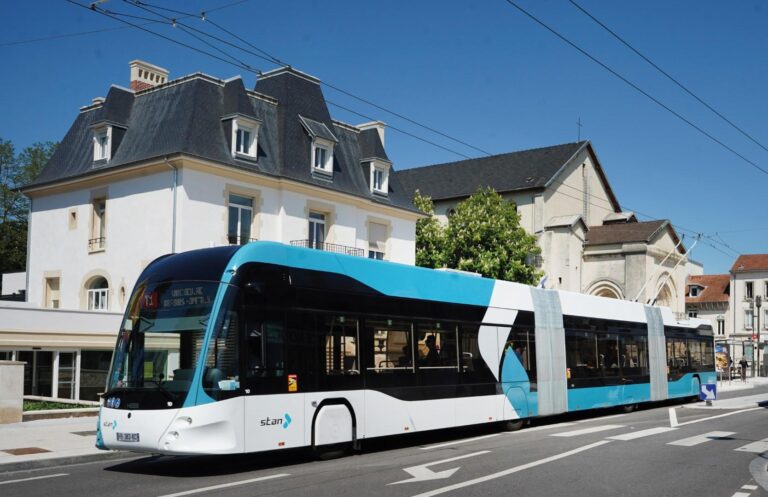France in Focus: BRT in Nancy and Nantes
As urban centers across the globe seek sustainable and efficient public transportation solutions, France is making significant strides with the implementation of Bus Rapid Transit (BRT) systems in cities like Nancy and Nantes. These systems promise to revolutionize the way residents and visitors navigate these vibrant locales, offering a blend of speed, reliability, and accessibility. In this article, we delve into the intricacies of BRT development in Nancy and Nantes, examining its impact on local communities, environmental benefits, and the challenges faced during this transformative journey. Join us as we explore how these French cities are reshaping urban mobility and setting benchmarks for future transport initiatives.
The Rise of Bus Rapid Transit in France’s Urban Landscapes
The implementation of Bus Rapid Transit (BRT) systems in cities like Nancy and Nantes has transformed urban mobility, offering a sustainable alternative to car travel. With dedicated lanes, streamlined boarding processes, and real-time information systems, these BRT networks provide efficient services that reduce congestion and enhance connectivity. Nantes, with its Chronobus network, has successfully increased ridership, boasting a significant reduction in carbon emissions. Similarly, Nancy’s BRT initiative is designed not only to ease travel but also to rejuvenate the urban landscape, demonstrating a commitment to integrating public transport with city planning.
The dual impact of these systems is evident. Firstly, they are improving the quality of life for residents by promoting cleaner air and reducing travel times. Secondly, they open avenues for economic growth by facilitating easier access to businesses and services. The success of BRT in these cities highlights the importance of public investment in infrastructure and urban planning. Key elements of these systems include:
- Dedicated Bus Lanes: Minimize traffic delays.
- Frequent Services: Ensure timely connections.
- Accessible Stations: Cater to all age groups.
- Eco-Friendly Vehicles: Reduce environmental footprint.
The rise of BRT not only shifts transportation paradigms but also fosters community engagement, making cities like Nancy and Nantes models for future urban planning across France.
Navigating the Impact of BRT on Commuter Experience in Nancy
The introduction of Bus Rapid Transit (BRT) systems in Nancy has significantly reshaped the daily travel routines of its commuters. The enhanced efficiency and reliability of bus services have drawn praise from many users who previously struggled with congestion and traditional public transport limitations. Key features, such as dedicated lanes and priority signaling, have transformed the commute, allowing passengers to enjoy shorter journey times and less stress. Riders are now experiencing a more seamless travel experience, unmarred by the unpredictable delays often associated with regular bus services.
Moreover, the accessibility improvements—accompanied by upgraded infrastructure—have made BRT an attractive option for a diverse range of commuters. Benefits include:
- Increased Frequency: Buses arrive at regular intervals, reducing wait times.
- Better Connectivity: Integration with other transport modes allows for easier transfers.
- Environmentally Friendly: BRT promotes reduced carbon emissions through efficient public transport.
As Nancy embraces this modern transport model, initial feedback highlights a substantial increase in overall satisfaction among local commuters, reflecting the promise of BRT systems in enhancing urban mobility.
A Comparative Analysis of BRT Implementation in Nantes
In Nantes, the introduction of Bus Rapid Transit (BRT) has significantly transformed urban mobility, emphasizing efficiency and sustainability. The BRT system, known as Chronobus, operates on dedicated lanes, allowing for swift transit through the city’s bustling areas, which is critical given Nantes’ growing population. Key features of the BRT implementation include:
- Dedicated bus lanes: Minimized delays from regular traffic.
- Frequent service: Buses run every 10-15 minutes during peak hours.
- Passenger-friendly stations: Equipped with real-time arrival information.
Moreover, the environmental benefits of the BRT system are notable. By encouraging a shift from private vehicles to public transport, Nantes aims to reduce its carbon footprint significantly. Statistical data illustrates this transition:
| Year | Percentage Reduction in Car Usage | BRT Ridership Growth |
|---|---|---|
| 2020 | 15% | 20% |
| 2021 | 18% | 30% |
| 2022 | 22% | 35% |
This data underscores the effectiveness of the BRT system in reshaping transportation dynamics within Nantes, making it a model for other cities to emulate.
Future Recommendations for Sustainable Urban Mobility Solutions
As cities like Nancy and Nantes continue to innovate their Bus Rapid Transit (BRT) systems, future recommendations should focus on enhancing integration and accessibility. This can be achieved by:
- Encouraging multimodal connections: Developing seamless transit links between BRT, cycling infrastructure, and pedestrian paths to promote sustainable transport choices.
- Implementing smart technology: Utilizing real-time data and AI to optimize route planning and improve user experiences through mobile applications.
- Enhancing community engagement: Involving local stakeholders in the planning process to ensure that the solutions meet diverse community needs.
Moreover, the focus should be on environmental impact and affordability. Future initiatives could include:
- Investing in green technology: Transitioning to electric buses to reduce emissions and improve urban air quality.
- Promoting affordability: Offering subsidies or reduced fare options for students, seniors, and low-income residents to ensure equitable access to public transport.
- Monitoring and evaluation: Regular analysis of BRT effectiveness and environmental impacts to adapt and refine strategies over time.
Concluding Remarks
In conclusion, the implementation of Bus Rapid Transit (BRT) systems in Nancy and Nantes underscores France’s commitment to sustainable urban mobility. As these cities embrace efficient public transportation solutions, they not only enhance commuter convenience but also tackle pressing environmental challenges. The BRT infrastructure promises to reshape urban landscapes, reduce congestion, and foster a greener future. As other cities look to France for inspiration, the successes and lessons gleaned from Nancy and Nantes could pave the way for a national shift towards more resilient and eco-friendly transport systems. For ongoing developments in transportation and urban planning, stay tuned to CBW Magazine.




